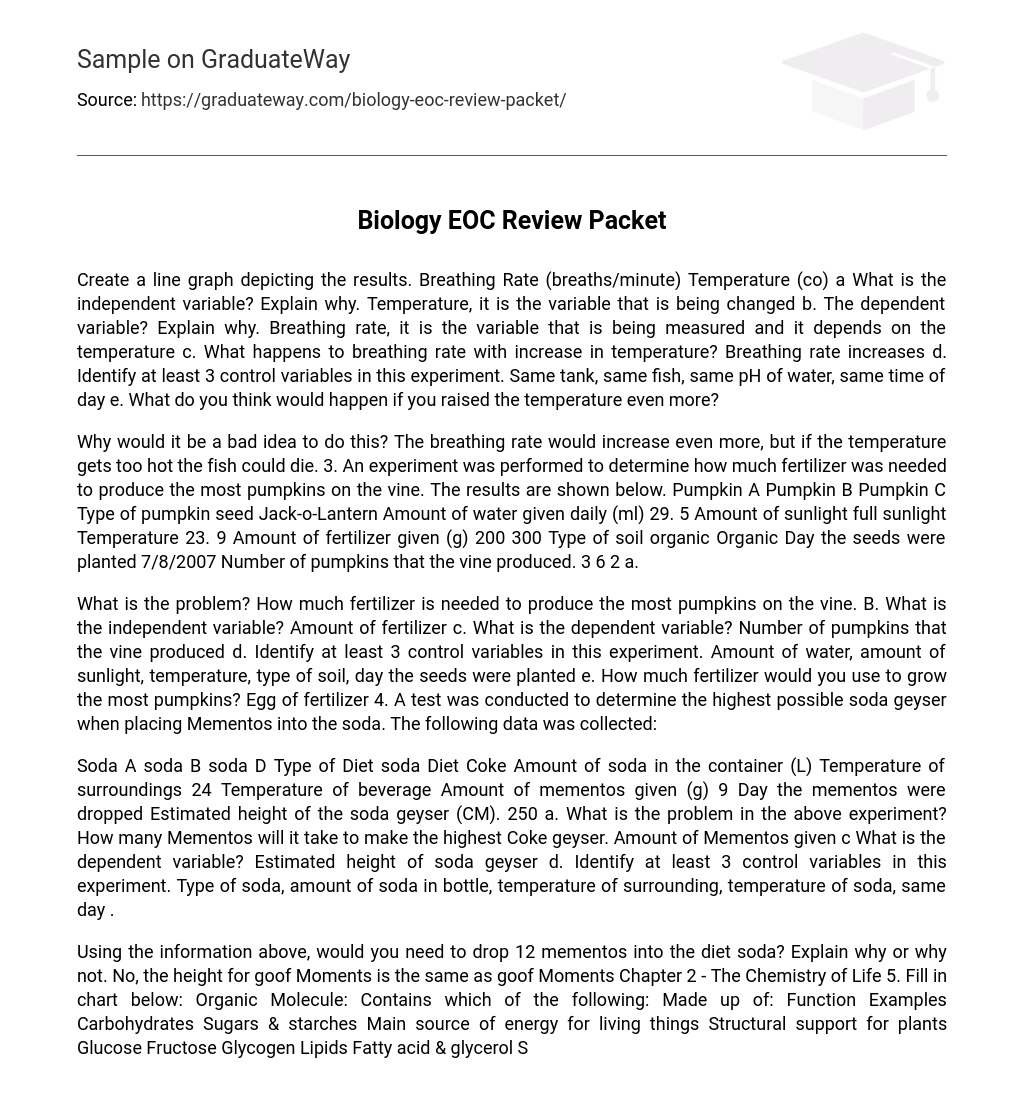Create a line graph depicting the results. Breathing Rate (breaths/minute) Temperature (co) a What is the independent variable? Explain why. Temperature, it is the variable that is being changed b. The dependent variable? Explain why. Breathing rate, it is the variable that is being measured and it depends on the temperature c. What happens to breathing rate with increase in temperature? Breathing rate increases d. Identify at least 3 control variables in this experiment. Same tank, same fish, same pH of water, same time of day e. What do you think would happen if you raised the temperature even more?
Why would it be a bad idea to do this? The breathing rate would increase even more, but if the temperature gets too hot the fish could die. 3. An experiment was performed to determine how much fertilizer was needed to produce the most pumpkins on the vine. The results are shown below. Pumpkin A Pumpkin B Pumpkin C Type of pumpkin seed Jack-o-Lantern Amount of water given daily (ml) 29. 5 Amount of sunlight full sunlight Temperature 23. 9 Amount of fertilizer given (g) 200 300 Type of soil organic Organic Day the seeds were planted 7/8/2007 Number of pumpkins that the vine produced. 3 6 2 a.
What is the problem? How much fertilizer is needed to produce the most pumpkins on the vine. B. What is the independent variable? Amount of fertilizer c. What is the dependent variable? Number of pumpkins that the vine produced d. Identify at least 3 control variables in this experiment. Amount of water, amount of sunlight, temperature, type of soil, day the seeds were planted e. How much fertilizer would you use to grow the most pumpkins? Egg of fertilizer 4. A test was conducted to determine the highest possible soda geyser when placing Mementos into the soda. The following data was collected:
Soda A soda B soda D Type of Diet soda Diet Coke Amount of soda in the container (L) Temperature of surroundings 24 Temperature of beverage Amount of mementos given (g) 9 Day the mementos were dropped Estimated height of the soda geyser (CM). 250 a. What is the problem in the above experiment? How many Mementos will it take to make the highest Coke geyser. Amount of Mementos given c What is the dependent variable? Estimated height of soda geyser d. Identify at least 3 control variables in this experiment. Type of soda, amount of soda in bottle, temperature of surrounding, temperature of soda, same day .
Using the information above, would you need to drop 12 mementos into the diet soda? Explain why or why not. No, the height for goof Moments is the same as goof Moments Chapter 2 – The Chemistry of Life 5. Fill in chart below: Organic Molecule: Contains which of the following: Made up of: Function Examples Carbohydrates Sugars & starches Main source of energy for living things Structural support for plants Glucose Fructose Glycogen Lipids Fatty acid & glycerol Store energy for living things Compose bi-layer in all cell membranes Leaves translucent spots on paper Steroids = chemical messengers Fats
Oils Waxes Proteins Amino Acids Regulate cell processes. Form bones & muscle. Transport substances in & out of cells. Fight off disease. (Immune System) Enzymes Nucleic Acids Nucleotides Stores genetic material DNA RNA 6. What is the function of an enzyme? Acts as a biological catalyst, speeds up the rate of a chemical reaction 7. How do temperature and pH affect enzymes? Most enzymes work best at body temperature, higher temps will cause the enzyme to no longer work properly 8. Why is water important to living things? Make up a lot of living things, universal solvent (dissolves many things) .
Water is POLAR (which mean it is + on one end and – on the other). 10. Define Surface Tension: Attraction between water molecules which allows insects and other objects to float a top the water 11. Rids have Neutral solutions have pH of 7 Chapter 7 – Cell Structure & Function (including Diffusion and Osmosis) 14. Define the following: a. Lipid belayed – double layer of lipids that make up a cell membrane b Protein Channels – help move bigger molecules through n the cell membrane c. Carbohydrates – check ID of substances entering the cell 5.
List the function of the following organelles: Organelle Nucleus Controls the functions of the cell Ribosome Make proteins Cell membrane Regulate what enters and leaves the cell Cell wall Provides protection and support for plant cells Mitochondria Creates energy for the cell by breaking down sugar Vacuoles Stores water, sugar, and other molecules for the cell Lissome Cleans up waste in the cell Googol apparatus Sorts and packages molecules for transport around the cell Chloroplast Creates energy for plant cells by converting sunlight into usable energy Endoplasmic reticulum
Make components (parts) for the cell 16. Label as many parts of the cells as you can. 17. Which is a plant cell – left or right? Left 18. List the hierarchy of cell organization from largest to smallest below: Organelle -?+ Cell -?+ Tissue -?+ Organ -?+ Organ System 19. Compare and contrast eukaryotic cells and prokaryotic cells. Eukaryotic: have a nucleus, more complex, organelles Prokaryotic: no nucleus, simple, no membrane-bound organelles 20. Compare and contrast plant cells and animal cells. Plant: Cell wall, one large vacuole, chloroplast Animal: Many small vacuoles, lissome, centurions





